Aq Qoyunlu
The Aq Qoyunlu[lower-alpha 3] (Azerbaijani: Ağ Qoyunlu, Persian: آق قویونلو) was a Persianate[9][10] Sunni[5] Turkoman[11][12][13] tribal confederation that ruled parts of present-day eastern Turkey from 1378 to 1501, and in their last decades also ruled Armenia, Azerbaijan, most of Iran, and Iraq.[14]
Part of a series on the |
|---|
| History of Azerbaijan |
 |
|
|
Part of a series on the |
|---|
| History of Turkey |
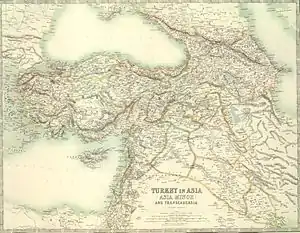 |
|
|
Part of a series on the |
|---|
| History of Iran |
 |
|
Timeline |
Aq Qoyunlu آق قویونلو | |||||||||
|---|---|---|---|---|---|---|---|---|---|
| 1378–1501 | |||||||||
 The Aq Qoyunlu confederation at its greatest extent | |||||||||
| Status | Confederate Sultanate | ||||||||
| Capital | |||||||||
| Common languages |
| ||||||||
| Religion | Sunni Islam[5] | ||||||||
| Government | Monarchy | ||||||||
| Ruler | |||||||||
• 1378–1435 | Kara Yuluk Osman | ||||||||
• 1501–1501 | Murad ibn Ya'qub | ||||||||
| Legislature | |||||||||
| Historical era | Medieval | ||||||||
• Established | 1378 | ||||||||
• Disestablished | 1501 | ||||||||
| |||||||||
History
Etymology
The name Aq Qoyunlu (meaning White Sheep) is first mentioned in late 14th century sources. It has been suggested that this name refer to old totemic symbols, but according to Rashid al-Din Hamadani, the Turks were forbidden to eat the flesh of their totem-animals, given the importance of mutton in the diet of pastoral nomads. Another hypothesis is that the name refer to the predominant color of their flocks.[2]
Origins
According to chronicles from the Byzantine Empire, the Aq Qoyunlu are first attested in the district of Bayburt south of the Pontic mountains from at least the 1340s,[15] and a number of their leaders, including the dynasty's founder, Qara Osman,[16] married Byzantine princesses.[17]
By the end of the Ilkhanid period in the mid-14th century, the Oghuz tribes that comprised the Aq Qoyunlu confederation roamed the summer pastures in Armenia, in particular the upper reaches of the Tigris river and winter pastures between the towns of Diyarbakır and Euvas. Since the end of the 14th century, Aq Qoyunlu waged constant wars with another tribal confederation of the Oghuz tribes, the Kara Koyunlu. The leading Aq Qoyunlu tribe was the Bayandur tribe.[18]
- Myth
Aq Qoyunlu Sultans claimed descent from Bayindir Khan, which was a grandson of Oghuz Khagan, the legendary ancestor of Oghuz Turks.[19]
Uzun Hasan
The Aq Qoyunlu Turkomans first acquired land in 1402, when Timur granted them all of Diyar Bakr in present-day Turkey. For a long time, the Aq Qoyunlu were unable to expand their territory, as the rival Kara Koyunlu or "Black Sheep Turkomans" kept them at bay. However, this changed with the rule of Uzun Hasan, who defeated the Black Sheep Turkoman leader Jahān Shāh in 1467.
After the defeat of a Timurid leader, Abu Sa'id Mirza, Uzun Hasan was able to take Baghdad along with territories around the Persian Gulf. He expanded into Iran as far east as Khorasan. However, around this time, the Ottoman Empire sought to expand eastwards, a serious threat that forced the Aq Qoyunlu into an alliance with the Karamanids of central Anatolia.
As early as 1464, Uzun Hasan had requested military aid from one of the Ottoman Empire's strongest enemies, Venice. Despite Venetian promises, this aid never arrived and, as a result, Uzun Hassan was defeated by the Ottomans at the Battle of Otlukbeli in 1473,[20] though this did not destroy the Aq Qoyunlu.
In 1470, Uzun selected Abu Bakr Tihrani to compile a history of the Aq Qoyunlu confederation.[21] The Kitab-i Diyarbakriyya, as it was called, referred to Uzun Hasan as sahib-qiran and was the first historical work to assign this title to a non-Timurid ruler.[21]
Sultan Ya'qub
When Uzun Hasan died early in 1478, he was succeeded by his son Khalil Mirza, but the latter was defeated by a confederation under his younger brother Ya'qub at the Battle of Khoy in July.[22]
Ya'qub, who reigned from 1478 to 1490, sustained the dynasty for a while longer. However, during the first four years of his reign there were seven pretenders to the throne who had to be put down.[23] Following Ya'qub's death, civil war again erupted, the Aq Qoyunlus destroyed themselves from within, and they ceased to be a threat to their neighbors. The early Safavids, who were followers of the Safaviyya religious order, began to undermine the allegiance of the Aq Qoyunlu. The Safavids and the Aq Qoyunlu met in battle in the city of Nakhchivan in 1501 and the Safavid leader Ismail I forced the Aq Qoyunlu to withdraw.[24]
In his retreat from the Safavids, the Aq Qoyunlu leader Alwand destroyed an autonomous state of the Aq Qoyunlu in Mardin. The last Aq Qoyunlu leader, Murad, brother of Alwand, was also defeated by the same Safavid leader. Though Murād briefly established himself in Baghdad in 1501, he soon withdrew back to Diyar Bakr, signaling the end of the Aq Qoyunlu rule.
Ahmed Bey
Amidst the struggle for power between Uzun Hasan's grandsons Baysungur (son of Yaqub) and Rustam (son of Maqsud), their cousin Ahmed Bey appeared on the stage. Ahmed Bey was the son of Uzun Hasan's eldest son Uğurlu Muhammad, who, in 1475, escaped to the Ottoman Empire, where the sultan, Mehmed the Conqueror, received Uğurlu Muhammad with kindness and gave him his daughter in marriage, of whom Ahmed Bey was born.[25]
According to Hasan Rumlu's Ahsan al-tavarikh, in 1496-7, Hasan Ali Tarkhani went to the Ottoman Empire to tell Sultan Bayezid II that Azerbaijan and Persian Iraq were defenceless and suggested that Ahmed Bey, heir to that kingdom, should be sent there with Ottoman troops. Beyazid agreed to this idea, and by May 1497 Ahmad Bey faced Rustam near Araxes and defeated him.[25]
Governance
The leaders of Aq Qoyunlu were from the Begundur or Bayandur clan of the Oghuz Turks[26] and were considered descendants of the semi-mythical founding father of the Oghuz, Oghuz Khagan.[27] The Bayandurs behaved like statesmen rather than warlords and gained the support of the merchant and feudal classes of Transcaucasia (present day Armenia, Azerbaijan, and Georgia).[27]
Uzun Hasan's conquest of most of mainland Iran shifted the seat of power to the east, where the Aq Qoyunlu adopted Iranian customs for administration and culture. In the Iranian areas, Uzun Hasan preserved the previous bureaucratic structure along with its secretaries, who belonged to families that had in a number of instances served under different dynasties for several generations. The four top civil posts of the Aq Qoyunlu were all occupied by Iranians, which under Uzun Hasan included; the vizier, who led the great council (divan); the mostawfi al-mamalek, high-ranking financial accountants; the mohrdar, who affixed the state seal; and the marakur "stable master", who supervised the royal court.[2] Culture flourished under the Aq Qoyunlu, who, although of coming from a Turkic background, sponsored Iranian culture. Uzun Hasan himself adopted it and ruled in the style of an Iranian king.[28]
In letters from the Ottoman Sultans, when addressing the kings of Aq Qoyunlu, such titles as Arabic: ملك الملوك الأيرانية "King of Iranian Kings", Arabic: سلطان السلاطين الإيرانية "Sultan of Iranian Sultans", Persian: شاهنشاه ایران خدیو عجم Shāhanshāh-e Irān Khadiv-e Ajam "Shahanshah of Iran and Ruler of Persia", Jamshid shawkat va Fereydun rāyat va Dārā derāyat "Powerful like Jamshid, flag of Fereydun and wise like Darius" have been used.[29] Uzun Hassan also held the title Padishah-i Irān "Padishah of Iran",[30] which was re-adopted again in the Safavid times through his distaff grandson Ismail I, founder of the Safavid Empire.
Gallery
 A flag (sanjak) belonging to Aq Qoyunlu during Uzun Hassan's reign. (Topkapı Palace museum).
A flag (sanjak) belonging to Aq Qoyunlu during Uzun Hassan's reign. (Topkapı Palace museum).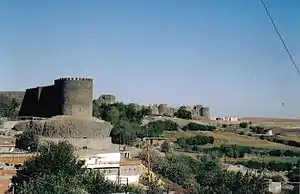 Aq Qoyunlu castle in Diyarbakır.
Aq Qoyunlu castle in Diyarbakır.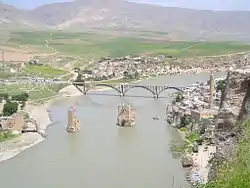 Historical Hasankeyf in Aq Qoyunlu territory.
Historical Hasankeyf in Aq Qoyunlu territory.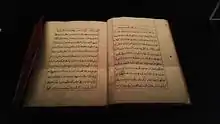
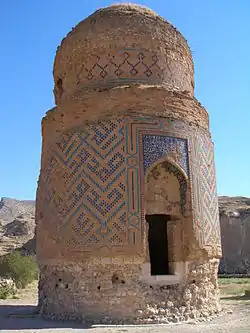 Zeynel Bey Mausoleum, formerly located in Hasankeyf.
Zeynel Bey Mausoleum, formerly located in Hasankeyf.
See also
- List of rulers of Aq Qoyunlu
- Turkmen invasions of Georgia
- Diarbakriya, the most important primary source about the dynasty.
- Bozulus
Notes
- ... and dedicated it to the Aqqoyunlu Sultan Yaʿqub (r. 1478–90), who himself wrote poetry in Azeri Turkish. [3]
- ...Persian was primarily the language of poetry in the Aq Qoyunlu court.[4]
- • Also referred to as the Aq Qoyunlu confederacy, Aq Qoyunlu sultanate, White Sheep confederacy or White Sheep Turkomans.
• Other spellings includes Ag Qoyunlu, Agh Qoyunlu or Ak Koyunlu.
• Also mentioned as Bayanduriyye in Iranian[6][7] and Ottoman sources.[8]
References
- Daniel T. Potts (2014). Nomadism in Iran: From Antiquity to the Modern Era. p. 7.
Indeed, the Bayundur clan to which the Aq-qoyunlu rulers belonged, bore the same name and tamgha (symbol) as that of an Oghuz clan.
- "AQ QOYUNLŪ". Encyclopaedia Iranica.
- Javadi & Burrill 2012.
- Erkinov 2015, p. 62.
- Michael M. Gunter, Historical dictionary of the Kurds (2010), p. 29
- Seyfettin Erşahin (2002). Akkoyunlular: siyasal, kültürel, ekonomik ve sosyal tarih (in Turkish). p. 317.
- Faruk Sümer. "Akkoyunlular" (in Turkish). TDV Islam Ansiklopedisi.
- International Journal of Turkish Studies - Volumes 4-5. University of Wisconsin. 1987. p. 272.
- Aq Qoyunlu, R. Quiring-Zoche, Encyclopædia Iranica, (December 15, 1986);"Christian sedentary inhabitants were not totally excluded from the economic, political, and social activities of the Āq Qoyunlū state and that Qara ʿOṯmān had at his command at least a rudimentary bureaucratic apparatus of the Iranian-Islamic type.."
"With the conquest of Iran, not only did the Āq Qoyunlū center of power shift eastward, but Iranian influences were soon brought to bear on their method of government and their culture.."" - Kaushik Roy, Military Transition in Early Modern Asia, 1400-1750, (Bloomsbury, 2014), 38;"Post-Mongol Persia and Iraq were ruled by two tribal confederations: Akkoyunlu (White Sheep) (1378–1507) and Qaraoyunlu (Black Sheep). They were Persianate Turkoman Confederations of Anatolia (Asia Minor) and Azerbaijan."
- "Ak Koyunlu". Encyclopaedia Britannica. "Ak Koyunlu, also spelled Aq Qoyunlu (“White Sheep”), Turkmen tribal federation that ruled northern Iraq, Azerbaijan, and eastern Anatolia from 1378 to 1508 ce."
- Mikaberidze, Alexander (2011). Conflict and Conquest in the Islamic World: A Historical Encyclopedia, vol. 1. Santa-Barbara, CA: ABC-Clio. p. 431. ISBN 978-159884-336-1. "His Qizilbash army overcame the massed forces of the dominant Ak Koyunlu (White Sheep) Turkomans at Sharur in 1501...".
- The Book of Dede Korkut (F.Sumer, A.Uysal, W.Walker ed.). University of Texas Press. 1972. p. Introduction. ISBN 0-292-70787-8. "Better known as Turkomans... the interim Ak-Koyunlu and Karakoyunlu dynasties..."
- electricpulp.com. "AQ QOYUNLŪ – Encyclopaedia Iranica". www.iranicaonline.org. Retrieved 25 March 2018.
- Sinclair, T.A. (1989). Eastern Turkey: An Architectural & Archaeological Survey, Volume I. Pindar Press. p. 111. ISBN 9780907132325.
- Minorsky, Vladimir (1955). "The Aq-qoyunlu and Land Reforms (Turkmenica, 11)". Bulletin of the School of Oriental and African Studies, University of London. 17 (3): 449. doi:10.1017/S0041977X00112376.
- Robert MacHenry. The New Encyclopædia Britannica, Encyclopædia Britannica, 1993, ISBN 0-85229-571-5, p. 184.
- Clifford Edmund Bosworth. The new Islamic dynasties: a chronological and genealogical manual. — Edinburgh University Press, 2004. p. 275—276. ISBN 0-7486-2137-7
- Cornell H. Fleischer (1986). Bureaucrat and intellectual in the Ottoman Empire. p. 287.
- Eagles 2014, p. 46.
- Markiewicz 2019, p. 184.
- Woods, John E. (1999) The Aqquyunlu: Clan, Confederation, Empire, University of Utah Press, Salt Lake City, p. 128, ISBN 0-87480-565-1
- Woods, John E. (1999) The Aqquyunlu: Clan, Confederation, Empire, University of Utah Press, Salt Lake City, p. 125, ISBN 0-87480-565-1
- Thomas & Chesworth 2015, p. 585.
- Vladimir Minorsky. "The Aq-qoyunlu and Land Reforms (Turkmenica, 11)", Bulletin of the School of Oriental and African Studies, University of London, 17/3 (1955): 458.
- C.E. Bosworth and R. Bulliet, The New Islamic Dynasties: A Chronological and Genealogical Manual , Columbia University Press, 1996, ISBN 0-231-10714-5, p. 275.
- Charles van der Leeuw. Azerbaijan: A Quest of Identity, a Short History, Palgrave Macmillan, ISBN 0-312-21903-2, p. 81
- Langaroodi & Negahban 2008.
- Muʾayyid S̲ābitī, ʻAlī (1967). Asnad va Namahha-yi Tarikhi (Historical documents and letters from early Islamic period towards the end of Shah Ismaʻil Safavi's reign.). Iranian culture & literature. Kitābkhānah-ʾi Ṭahūrī., pp. 193, 274, 315, 330, 332, 422 and 430. See also: Abdul Hussein Navai, Asnaad o Mokatebaat Tarikhi Iran (Historical sources and letters of Iran), Tehran, Bongaah Tarjomeh and Nashr-e-Ketab, 2536, pages 578,657, 701-702 and 707
- H.R. Roemer, "The Safavid Period", in Cambridge History of Iran, Vol. VI, Cambridge University Press 1986, p. 339: "Further evidence of a desire to follow in the line of Turkmen rulers is Ismail's assumption of the title 'Padishah-i-Iran', previously held by Uzun Hasan."
Sources
- Bosworth, Clifford (1996) The New Islamic Dynasties: A Chronological and Genealogical Manual (2nd ed.) Columbia University Press, New York, ISBN 0-231-10714-5
- Eagles, Jonathan (2014). Stephen the Great and Balkan Nationalism: Moldova and Eastern European History. I.B. Tauris.
- Erkinov, Aftandil (2015). Translated by Bean, Scott. "From Herat to Shiraz: the Unique Manuscript (876/1471) of 'Alī Shīr Nawā'ī's Poetry from Aq Qoyunlu Circle". Cahiers d'Asie centrale. 24: 47-79.
- Langaroodi, Reza Rezazadeh; Negahban, Farzin (2008). "Āq-qūyūnlū". In Madelung, Wilferd; Daftary, Farhad (eds.). Encyclopaedia Islamica Online. Brill Online. ISSN 1875-9831.CS1 maint: ref=harv (link)
- Javadi, H.; Burrill, K. (May 24, 2012). "AZERBAIJAN x. Azeri Turkish Literature". Encyclopaedia Iranica.
- Markiewicz, Christopher (2019). The Crisis of Kingship in Late Medieval Islam: Persian Emigres and the Making of Ottoman Sovereignty. Cambridge University Press.
- Morby, John (2002) Dynasties of the World: A Chronological and Genealogical Handbook (2nd ed.) Oxford University Press, Oxford, England, ISBN 0-19-860473-4
- Thomas, David; Chesworth, John A., eds. (2015). Christian-Muslim Relations. A Bibliographical History:Central and Eastern Europe, Asia, Africa and South America. Vol. 7. Brill.
- Woods, John E. (1999) The Aqquyunlu: Clan, Confederation, Empire (2nd ed.) University of Utah Press, Salt Lake City, ISBN 0-87480-565-1


